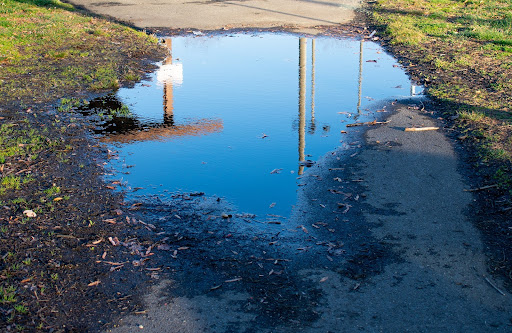
Standing water can lead to devastating consequences that damage your lawn and house. It can even compromise your health if left unchecked. How do you prevent standing water from damaging your property? Let’s find out.
Standing water includes any body of stagnant water that does not flow. Common examples in residential areas include ponds and water puddles. What causes standing water? Here are some of the most common reasons why water may stagnate in your yard:
Standing water can lead to all sorts of problems. It could cause erosion and water damage to roads, walkways, and even your home’s foundation. How do you solve water ponding? Here are the best ways to prevent standing water.
Standing water correction involves ensuring all your downspouts and gutters are functioning properly. Make sure they are not clogged with leaves and other debris. Otherwise, rainwater might overflow from the sides and seep into your home’s foundation.
We recommend cleaning the gutters and downspouts once every season. It’s also important to ensure the downspouts redirect rainwater at least eight feet away from the foundation. If not, you can purchase flexible downspout extenders to redirect the flow of rainwater.
How do you fix standing water on concrete? One of the best ways is to grade your yard. Ensure all the soil around the house slopes 4-6 inches over the 10 feet of space surrounding the home. You can add dense soil or clay around the foundation, ensuring it’s sloped downward to redirect any water. However, keep soil or dirt at least 6 inches from the siding. This will prevent termites, carpenter ants, and insects from invading the house.
French drains protect your foundation by redirecting any standing water away from the home. All you need to do is dig a ditch around the foundation’s perimeter and place a perforated pipe in the trench. Afterward, pour gravel over the top of the pipe. Rainwater can filter through the gravel and travel through the pipe away from the property.
Is your basement prone to retaining moisture? The best way to protect your property is to waterproof the basement and the crawl space. This will keep your foundation free of rot and mold, preserve its structural integrity, and protect your family’s health.
If you’re up for the task, waterproofing involves installing an interior drainage system that collects water from the crawl space and basement. All you need to do is dig a trench around the interior and drill moisture weep holes through the inside of the base block.
Afterward, a drainage pipe will be installed in the trench and covered with gravel. A sump pump or gravity discharge system should remove the water from the space it’s collected.
If water pools in your yard after heavy rain, it might be because the yard has a downward slope collecting the water. In this case, consider installing a rain garden at the bottom of the valley or slope to absorb the rainwater. This prevents flooding and improves your lawn’s overall health.
Choose native ornamental grasses, shrubs, and flowers to create your rain garden. These are often the types of greenery you find in lowlands and swamps. Grasses, rushes, and sedges are especially effective because they have deep, interconnected roots.
Most people think it’s enough to water their lawn every so often simply. However, different grass, plants, and soil types require different amounts of water. Some will also need more frequent watering than others.
As a rule of thumb, warm-season grasses need more watering in the summer. Meanwhile, cool-season grasses need more watering during the fall and spring. If you’re using turfgrass, it may need deep but relatively infrequent watering.
Aerating and dethatching the lawn is an effective way to eliminate standing water. Remove any roots, leaves, and grass stems built up over time. These often form tightly woven layers that prevent standing water from seeping into the soil. Lawns need a healthy amount of thatch, but too much can harm the lawn’s health.
Three soil types are common in residential lawns: clay, sand, and loam. Sand and loam absorb and pass water quickly, but clay is prone to trapping water.
If your lawn is clay, consider amending the soil with compost to improve drainage. Doing so breaks up the clay so water can pass through it faster. However, it’s vital to aerate and dethatch the lawn before amending the soil. Otherwise, it won’t be as effective, as the organic matter may not reach the soil as efficiently.
Most property owners use cement, concrete, or asphalt concrete for their driveways, paths, and patios. However, these materials are prone to collecting standing rainwater and the pollutants that come with it.
Instead, use permeable hardscaping like stepping stones, gravel, and pavers. These allow the water to filter through and prevent runoff and pooling. You can install a drain or improve your existing drainage to make it more effective.
It’s important to prevent standing water on your property. Doing so will lengthen the lifespan of your hardscaping and lawn and your home’s foundation. Moreover, it creates a healthier environment as standing water is a breeding ground for insects and bacteria.
If standing water is a big issue for you, it might be wise to seek professional help. Pothole Repair Carolinas offers the best services around North and South Carolina. Call us today at 704-227-0468 or contact us online for more information!
RELATED ARTICLES: